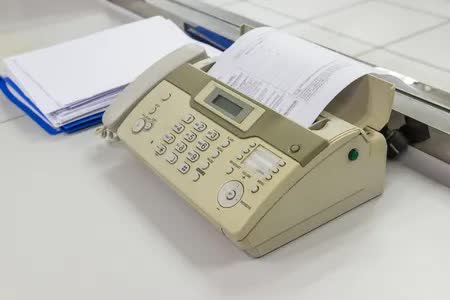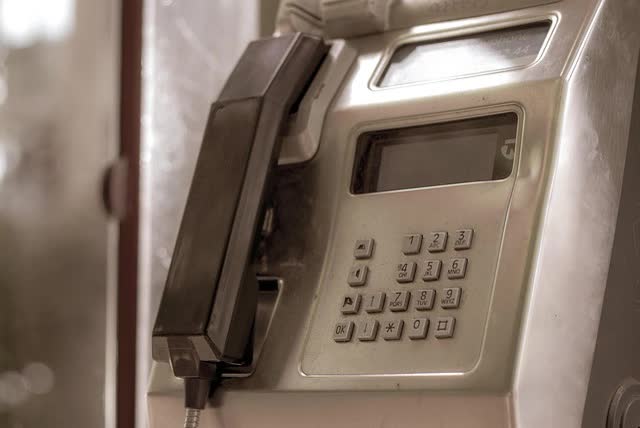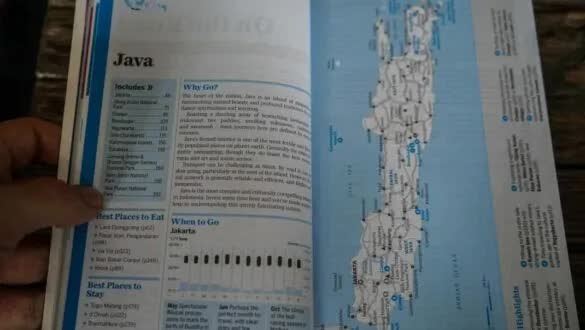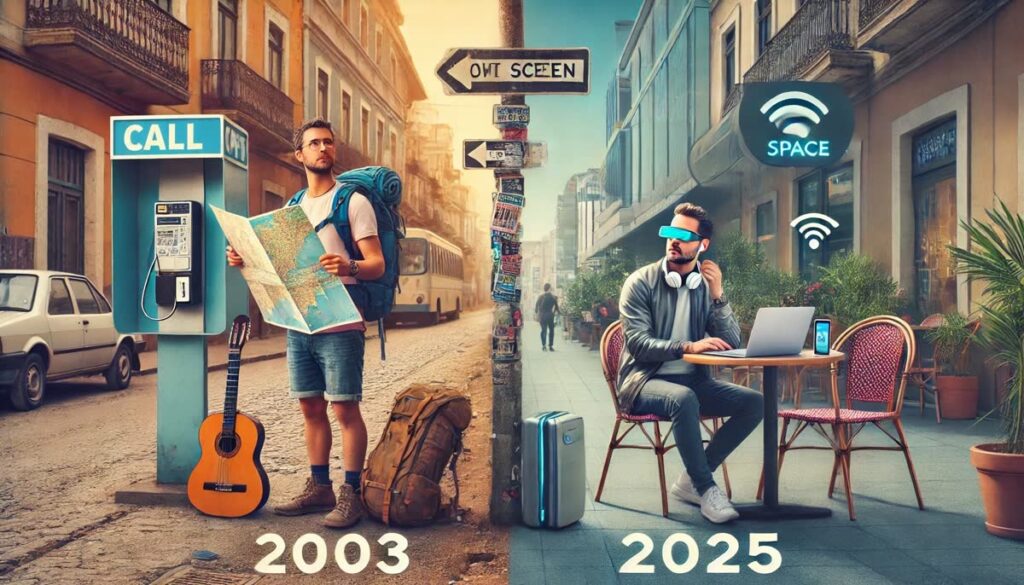How I Turned The Voice Notes On My Phone Into This Story
The blog post below was built entirely from voice notes on my phone — no outline, no script, just spoken thoughts turned into a long-form story.
This blog is about how I became a digital nomad back in 2003.
👇 Here’s a 2-minute excerpt from the original recording:
I use an AI workflow built on a content library of my previous work. This works alongside the voice notes that I transcribe. Together, your voice notes become a fully optimized blog post, something like this.
How I Became A Digital Nomad in 2003
In 2025, becoming a digital nomad is simple. Get yourself a remote job or spin up a half-decent side hustle. Pick a cheap country, book an Airbnb, buy a plane ticket, and go.
My digital nomad history was different. In 2003 there was no Airbnb, smartphones or social media. How did I become a digital nomad in 2003? This is part one of my story.
Back in 2003, when I became a digital nomad, things weren’t so simple. Remote working wasn’t really a thing. The internet was still niche, nobody had smartphones, and there were no Facebook groups. In fact, the term digital nomad didn’t even exist.
When I left Manchester with a cheap laptop and half a business, people told me I was crazy. My former employer laughed in my face. When I suggested taking my laptop abroad and doing some freelance work. He handed me a one pound coin and suggested I buy a lottery ticket instead.
In 2003 you worked in the office. You started at 9am and you finished at 5pm. That was the culture. It was something I hated, and no longer wanted to be a part of.
Remote work is no longer a perk but a norm for many, and it’s paved the way for the digital nomad lifestyle—a blend of work and travel that transforms every corner of the world into a potential office. MEDIUM – Apler Y
A Digital Nomad History – Understanding: What Being a Nomad Was Really Like in 2003
Before technology made everything easy and globally connected. Technology was a funny little thing we were trying to understand. In the early 2000’s the internet was in it’s infancy. Laptops were growing in popularity and smart phones were a distant dream.
Nobody worked in foreign countries, unless you had a job in one. There were no co-working spaces. There wasn’t even hotel Wi-Fi. I built my first digital nomad business from a smoky Spanish cyber café. Where I paid by the minute for internet.
I had to slip the owner extra cash just to plug in my bulky laptop. Otherwise I was stuck on one of his battered old virus-infested machines. In the early 2000’s a foreign internet cafe was used for sending e-mail and checking the news. They certainly weren’t used for trying to start a business.
Payments? Forget payment links, Stripe, or Wise apps. Most of my early clients paid by bankers check. PayPal existed, but in 2003 it was mostly used as a tool for eBay sellers.

When I was in Manchester my first business ran on a fax machine. I remember getting my first order and running to a Staples stationary store to buy the cheapest fax machine they had. Because my client had asked me to “fax over the order.”
The first problem I needed to solve before I hit road was, how will I get paid?
Carrying a fax machine in your hand luggage was insanity. I eventually found a fax-to-email service using local-rate phone numbers. Before that, I would wait for an e-mail from a friend back in England. As she had my fax machine sitting on her kitchen table.
I had another friend who would visit my city center mail box once a week. They would collect any bankers checks I had received, before paying them into my account. In 2025, I send a Stripe link, and take payments to my Wise international currency card. In 2003, getting paid was a problem that needed solving.
When I moved to Spain in 2003, I found myself in an apartment with no internet and no phone line. My local option for internet was the dingy pay by the minute internet café. When I wanted to make phone calls I had an international calling card.

Using the calling card involved going to a payphone on a quiet street. You would call a number. Then, tap in a 16-digit code before dialing the number you actually needed.
Some of the old Spanish time share sales companies would hire telephone sales people to work like this. I do not know how they did it. After hours of telephone sales they must have had blisters on their fingers.
Eventually I paid a small fortune to get a landline phone installed just so I could call clients. The landline phone came with internet, and a long data cable. As my apartment was overlooking the beach. In 2003, I achieved the dream of working on the beach. Thanks to a very long internet cable.
Then came Skype, voice over IP. A phone on my laptop, this was incredible. Suddenly I could make phone calls over the internet, It was revolutionary. In 2003, getting Skype working felt like I and discovered fire. In 2003, Skype no longer exists .
Improvisation and Hustle: Early Digital Nomad History and Survival
In 2004, I pivoted into something completely different: a pirate hostel. I rented a big apartment with a huge terrace in a sleepy Spanish surf town, and introduced the concept of “urban camping.”
There was no Airbnb to advertise, or Facebook groups to post in. So, every day, I would take my rucksack to the bus stop and hustle travelers as they stepped off the bus. As nobody pre-booked room back then. It was easy to meet people, and ask them if they needed a place to stay,

At the time I was offering apartment facilities for less money than a hostel bed. I also had access to a swimming pool which was a big selling point.
My daily trips to the bus stop would always be rewarded with some new backpacker friends to bring back to my apartment. This was a great way to make money and have a good time. That old Spanish apartment turned into a non stop party during the summer months.
Word of mouth eventually spread, and backpackers would occasionally show up at my door asking for “Mr. Tan.” Because some travelers in Barcelona or wherever, had told them I had a cool place to stay.
A Digital Nomad History – How Did You Get Online in 2008?
By 2008, I was back on the road with a laptop and a few side hustles. I was drop-shipping and selling a digital consultancy service. My attitude was simple, anything and everything, by any means possible. All I wanted was a little cash and the ability to keep moving.
Internet access was still a battle. When I was in Bulgaria, I bought a homemade Wi-Fi sniffer from a hacker. It looked like something out of a Cold War spy movie: a heavy coaxial cable and a plastic plate antenna. I’d strap it to the roof of my mountain apartment and leech a signal from a monastery across the valley. That setup kept me online for months.
In India, things were even wilder. The electricity would come back on and the internet would immediately cut out, and vice versa. Uploading a single eBay photo could take hours.
I spent months in Delhi hustling wholesalers for cheap stock, then escaped to the mountains where uploading one picture became an all-day project.
That was the essence of the digital nomad lifestyle in the 2000s: grit, survival, and improvisation. Forget sales funnels and social media marketing. Your number one skill was thinking on your feet and fixing problems as they exploded in real time.
The digital nomad lifestyle has transformed from fringe to mainstream—by 2024, an estimated 40 million people around the world are embracing location-independent work. MBO Partners
From Lonely Planet to Lonely Screens – A Digital Nomad History In Evolution

Travel itself was also very different. Arriving in a new town meant no pre-booked Airbnb. When I wanted to find long term accommodation. I would find a bar, order a drink, and see who I got talking to. That’s how you found a room back then. No apps, no sterile online reviews. Just a few beers and luck.
I remember arriving in Mumbai at 3am. My “booking system” was a guidebook. Where I had the name of the guesthouse marked yellow highlighter. When my pre-paid taxi eventually got there. The taxi driver followed me into the hotel, then upstairs. When I closed my door in his face, he started banging on it. I think he was demanding more money. Today, people panic if their Uber driver cancels. This guy would have got in bed with me if the door hadn’t had a lock on it.
The first time I traveled, about ten of us ended up following one girl because she had a copy of The Lonely Planet. She was the Pied Piper, leading us down a hill to find a hostel. That little crew stuck together for days, swapping emails and stories.
That’s how community worked before social media made it sterile and algorithmic. You bumped into strangers on the street and swapped information and stories. Rich hippies, online hustlers, and backpackers. It did not matter who you were. We were all in it together.
Becoming a Digital Nomad in 2025
Now, fast-forward to today. Becoming a digital nomad in 2025 is almost boring.
- Find a remote job or spin up a side hustle.
- Pick a country with a digital nomad visa.
- Book a flight, an Airbnb, maybe a co-working space.
- Connect to Wi-Fi and you’re good to go.
You can run a business from a noodle stand in the middle of nowhere with better internet than I ever had in 2003. You don’t need a fax machine, a calling card, or a ghetto Wi-Fi antenna strapped to your roof. You just need a laptop and the guts to book that ticket.
What You Can Take From 2003
You do not need the ghetto hack skills I used to get online. You don’t need international sign language and funny little books filled with pictures you could point at when you were having a language crisis.
But you did, and still do, need determination. Back in 2003, every step took determination. Nearly every step was into the unknown. If you ask me, the best thing any digital nomad could do in 2025 is this: go somewhere blind. Don’t plan. Don’t watch YouTube videos and live the trip before you do it. Just turn up and see what happens.
If you’re thinking about becoming a digital nomad today, don’t just rely on the easy path. Bring some of that old-school grit with you. Talk to strangers. Take risks. Do things the apps can’t plan for you. Because in the end, it’s not the convenience that makes the journey worth it. It’s the stories — and do I have some stories.
If you are interested in creating content like this, using the voice notes on your phone. Contact me at og@ognomad.com


